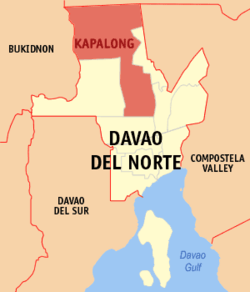Kapalong
Kapalong, officially the Municipality of Kapalong, is a 1st class municipality in the province of Davao del Norte, Philippines. According to the 2015 census, it has a population of 76,334 people.[3]
Kapalong | |
|---|---|
| Municipality of Kapalong | |
 Map of Davao del Norte with Kapalong highlighted | |

| |
.svg.png) Kapalong Location within the Philippines | |
| Coordinates: 7°35′08″N 125°42′19″E | |
| Country | |
| Region | Davao Region (Region XI) |
| Province | Davao del Norte |
| District | 1st District |
| Founded | July 8, 1948 |
| Barangays | 14 (see Barangays) |
| Government | |
| • Type | Sangguniang Bayan |
| • Mayor | Maria Theresa R. Timbol |
| • Vice Mayor | Edgardo L. Timbol |
| • Congressman | Pantaleon D. Alvarez |
| • Electorate | 46,921 voters (2019) |
| Area | |
| • Total | 830.01 km2 (320.47 sq mi) |
| Elevation | 24.5 m (80.4 ft) |
| Population (2015 census)[3] | |
| • Total | 76,334 |
| • Density | 92/km2 (240/sq mi) |
| • Households | 17,150 |
| Economy | |
| • Income class | 1st municipal income class |
| • Poverty incidence | 31.19% (2015)[4] |
| • Revenue (₱) | 252,715,841.42 (2016) |
| Time zone | UTC+8 (PST) |
| ZIP code | 8113 |
| PSGC | |
| IDD : area code | +63 (0)84 |
| Climate type | tropical rainforest climate |
| Native languages | Davawenyo Cebuano Ata Manobo Kalagan language Tagalog |
| Website | www |
History
The town was founded in July 8, 1948, from the Municipal District of Tagum, which was formed in 1918. It was one of the oldest towns in Davao del Norte Province, others being Tagum, in 1941; and Panabo, in 1949, both of which were converted into cities almost 50 years later. Though the towns of Santo Tomas, Talaingod and portion of San Isidro emerged from Kapalong in 1959, 1991, and 2004 respectively, it is still the largest town by land area in the province of Davao del Norte.
Barangays
Kapalong is politically subdivided into 14 barangays.
- Semong
- Florida
- Gabuyan
- Gupitan
- Capungagan
- Katipunan
- Luna
- Mabantao
- Mamacao
- Pag-asa
- Maniki (Poblacion)
- Sampao
- Sua-on
- Tiburcia
Climate
| Climate data for Kapalong, Davao del Norte | |||||||||||||
|---|---|---|---|---|---|---|---|---|---|---|---|---|---|
| Month | Jan | Feb | Mar | Apr | May | Jun | Jul | Aug | Sep | Oct | Nov | Dec | Year |
| Average high °C (°F) | 28 (82) |
28 (82) |
29 (84) |
31 (88) |
31 (88) |
30 (86) |
30 (86) |
31 (88) |
31 (88) |
31 (88) |
30 (86) |
29 (84) |
30 (86) |
| Average low °C (°F) | 22 (72) |
22 (72) |
22 (72) |
22 (72) |
23 (73) |
24 (75) |
23 (73) |
23 (73) |
23 (73) |
23 (73) |
23 (73) |
23 (73) |
23 (73) |
| Average precipitation mm (inches) | 63 (2.5) |
50 (2.0) |
35 (1.4) |
22 (0.9) |
47 (1.9) |
68 (2.7) |
51 (2.0) |
53 (2.1) |
49 (1.9) |
47 (1.9) |
39 (1.5) |
38 (1.5) |
562 (22.3) |
| Average rainy days | 15.0 | 12.6 | 10.4 | 8.2 | 18.8 | 22.5 | 21.2 | 20.5 | 20.3 | 20.3 | 14.4 | 11.7 | 195.9 |
| Source: Meteoblue [5] | |||||||||||||
Demographics
| Population census of Kapalong | ||
|---|---|---|
| Year | Pop. | ±% p.a. |
| 1939 | 5,555 | — |
| 1948 | 5,878 | +0.63% |
| 1960 | 12,067 | +6.18% |
| 1970 | 20,225 | +5.29% |
| 1975 | 33,362 | +10.56% |
| 1980 | 42,869 | +5.14% |
| 1990 | 66,030 | +4.42% |
| 1995 | 62,183 | −1.12% |
| 2000 | 63,650 | +0.50% |
| 2007 | 61,763 | −0.41% |
| 2010 | 68,261 | +3.71% |
| 2015 | 76,334 | +2.15% |
| Source: Philippine Statistics Authority[3][6][7][8] | ||
References
- "Municipality". Quezon City, Philippines: Department of the Interior and Local Government. Retrieved 31 May 2013.
- "Province: Davao del Norte". PSGC Interactive. Quezon City, Philippines: Philippine Statistics Authority. Retrieved 12 November 2016.
- Census of Population (2015). "Region XI (Davao Region)". Total Population by Province, City, Municipality and Barangay. PSA. Retrieved 20 June 2016.
- "PSA releases the 2015 Municipal and City Level Poverty Estimates". Quezon City, Philippines. Retrieved 12 October 2019.
- "Kapalong: Average Temperatures and Rainfall". Meteoblue. Retrieved 29 February 2020.
- Census of Population and Housing (2010). "Region XI (Davao Region)". Total Population by Province, City, Municipality and Barangay. NSO. Retrieved 29 June 2016.
- Censuses of Population (1903–2007). "Region XI (Davao Region)". Table 1. Population Enumerated in Various Censuses by Province/Highly Urbanized City: 1903 to 2007. NSO.
- "Province of Davao del Norte". Municipality Population Data. Local Water Utilities Administration Research Division. Retrieved 17 December 2016.
External links
This article is issued from Wikipedia. The text is licensed under Creative Commons - Attribution - Sharealike. Additional terms may apply for the media files.